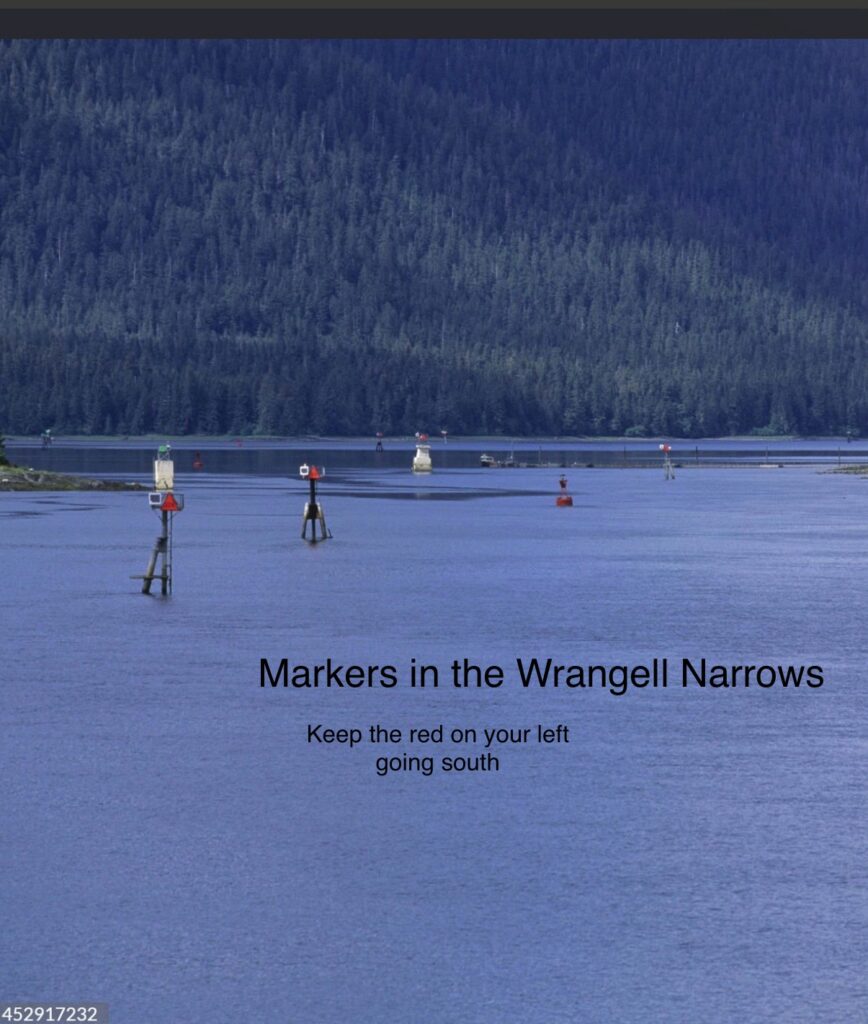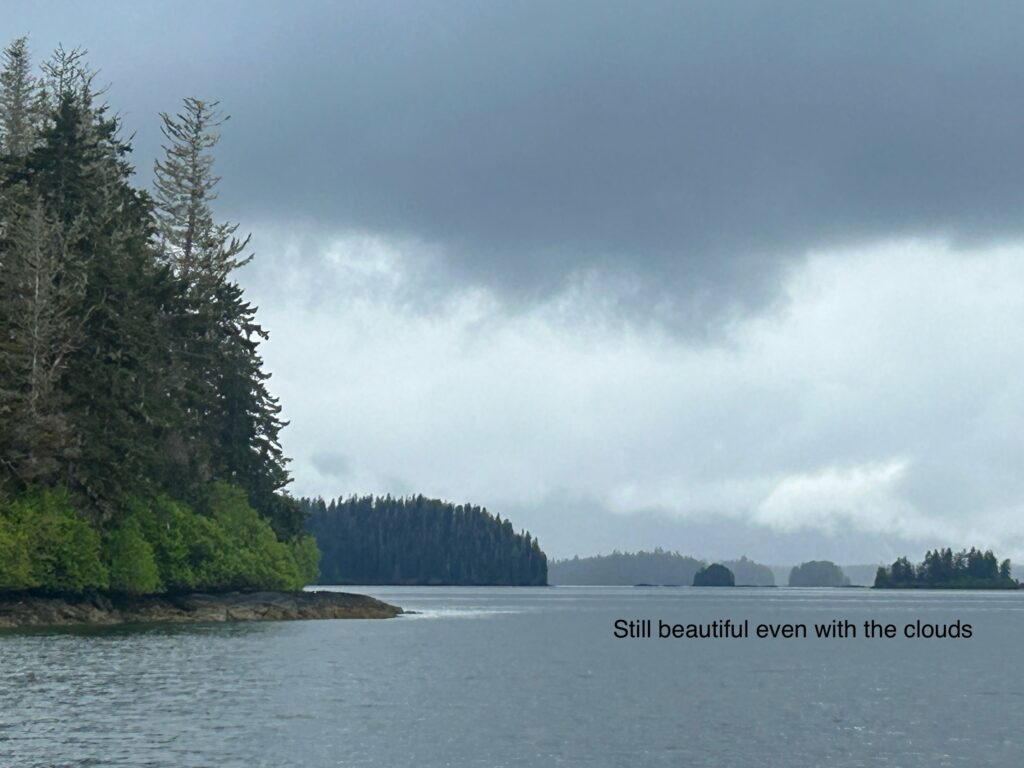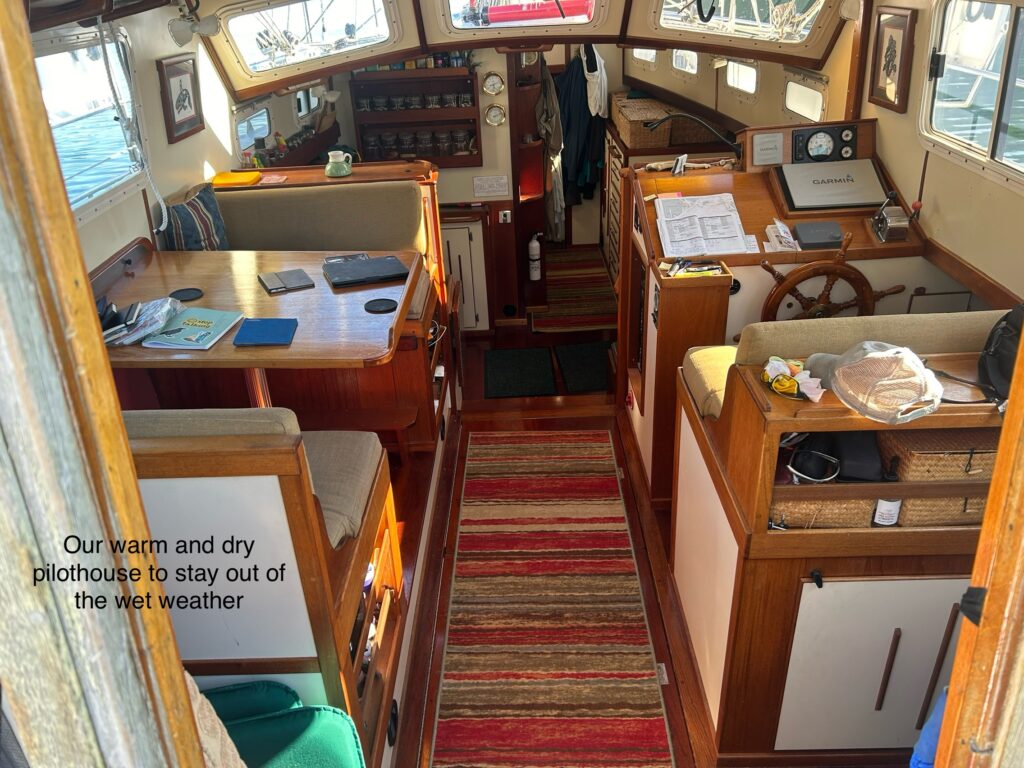Dear friends and family,
This is what a transit day on a small boat is like in alaska:
There have been many days getting ourselves and the boat ready for travel. We spent weeks doing maintenance and cleaning to have the ship systems ready and working for another season. We spent over $700 at Costco buying large containers of shipboard food and sent these up via the Alaska Marine Lines barge. Even after paying for the barge it is a deal compared to buying the same items in small quantities in alaska and paying the premium prices.
Day before departure saw us in both grocery stores filling in the missing items and stocking up on fresh fruits and vegetables and refrigerated foods. Now both little frigs and even tinier freezers were full. It seemed about the amount of food that I stocked to cross an ocean in my earlier life. All storage bins were overflowing. Maybe we could just stay in the harbor and eat our way through the accumulated stores?
But no, we had to actually leave the harbor.
So we set a 0930 departure time, which would allow for a 3.5 foot tide over low water which should let us out easily. Easily done on the chart, less so with the skipper’s gut.
This timing should put us at the center of the Wrangell Narrows at slack high tide. What are the Narrows? This is the channel that connects through the islands to get from the lower end of Southeast Alaska to the upper end. It can be narrow and shallow in spots unless you time it to ride the tide into the middle and then ride the outgoing tide out the north end as well. And we did.
Turned out our 0930 start did allow an easy exit from our harbor. It was choppy and up to 15 knots of wind on the port beam, so we set the mainsail to steady us and give us a lift in speed, which it did nicely. The wind shifted steadily as we crossed between islands to Sumner Strait and the entrance to the Narrows. With this sail assisted speed, we got to the entrance in good time to make the middle by high slack tide.
It’s 42 degrees F, plus the cold wind, which kept us confined to the warm pilothouse to steer and navigate. I often remember sitting outside in a cold cockpit with no inside steering on a 1987 trip on the East Coast of the US.
Summer in Maine made for fantastic cruising between the rocky islands. Many mornings were fog filled, but it usually burned off by noon. There were so many islands to explore that we kind of lost track of our calendar and the timing for the trip south by winter. Suddenly it’s November and we are sailing south past New York City to enter the Delaware River in a snowstorm. Oh yeah, note to self “ November could be wintry this far north”. We had a tiny inefficient heater, and combined with wearing all our layers of clothing available kept us reasonably warm, which really means that we wouldn’t freeze to death, but we sure were uncomfortable.
We were able to anchor safely each night and crawl under a warm quilt, but each morning we bundled up to sit in the cold and snowy air to motor and sail south. Through the Chesapeake and into Virginia we reached “The Ditch” which is what the cool kids call the Intracoastal Waterway, which, depending on the height of your mast ( to clear fixed bridges), can take you through this connection of natural and manmade canals most of the way to Florida.
We now started to meet other cruising sailors, most of whom were just starting their new cruising lifestyle. As we socialized, they learned that we had already crossed the feared Bay of Biscay, and even crossed the Atlantic Ocean. This gave us social status in this niche group.
They sure were impressed , and you might say “ perplexed” a day later when they motored by our stern, as the bow was impaled in the flooded tree forest to the side of the channel. It turned out ( which happens to be a good choice of words) that I was standing in the cockpit with my legs straddling the tiller to steer, to be able to keep my freezing hands warm in my pockets, Nancy thought it would be cute to sneak up behind me and goose me by surprise. I reacted by turning rapidly around towards her, forcing the rudder to that side and driving the fast moving boat directly into the flooded woods. Stuck fast.
I had studied methods for getting unstuck, using what is called a “kedge” anchor, rowing it out behind us, dropping it, and then cranking up the line on a winch to pull us backwards to extricate ourselves. Six times I set this anchor and six tree rootwads I pulled off the bottom, leaving us still stuck. So much for my self-sufficiency.
Eventually a big power boat un-impaled us and we were on our way again. Our desire to enjoy yesterday’s status was diminished, so we anchored far away from our southbound mentees.
Next cruising boat: inside steering and a real heater. Especially for northern latitude sailing. Welcome to Hongvi- present boat.
Check. We have that and used it here this spring cold of 2024. Oh, did I mention that it was raining? Steadily it poured, reaching the forecasted half inch for the day. Visibility was just adequate to see the land around us and check for traffic.
The Narrows has 60 or so channel markers to look for and follow to stay in deep water. Liz was calling out the numbers as I spotted them on the chartplotter. It’s not really hard to find your way as it’s well marked.
We blew by Petersburg on our way out of the top of the Channel, riding the outbound tide at about eleven knots over the bottom. Now we had over five hours of travel with three to go to our intended anchorage.
I felt tired from the combination of nerves of leaving at low tide, peering through the wind and rainy conditions , then focusing on the numbered channel markers in the Narrows.
Now Celeste, our electronic autopilot, was engaged and could steer us easily on a very wide channel.
We set out a lunch on the pilothouse table of cheese and crackers, carrots, humus, and sliced apple to forage on as we motored along. No standing out in the cold steering with my legs. Instead it was autopilot steering as we enjoyed the snacks inside the heated pilothouse.
One more challenge: coax Hongvi into the entrance of Portage Bay at the now low tide level. One guidebook suggested entering the narrow channel entrance between the two shoals only at high tide. We were doing the opposite. Good idea to have a guidebook, if you don’t follow the advice inside?
We both dressed in full foulies ( foul weather outfits) and stood in the cockpit as we motored very slowly in, expecting to touch bottom any second. Perfect timing as more rain decided to fall heavily at the same time. So, going 1.5 knots, standing in the cold wind and rain, we puttered in.
It never got below 9 feet under our keel, so we slipped inside, found a nearby spot and dropped our anchor in 20 feet of water. Once it was set we crawled inside, dried off and made a quick pressure cooker dinner and slept as if dead.
One long day. Close to ten hours of mostly motoring and navigating.
Sending love,
Charley





Wonderful to be back in the middle of your great adventures
Exciting, maybe, and beautiful, but doesn’t sound that pleasant. Toooo cold! I like to read about it in my comfortable, air conditioned house.
Charlie, I’m always impressed by your planning, and focus. Looks other-worldly up there. Cheers, Gregg
Great mix of funny past anecdotes and current adventures! Loving the photos. Keep the stories coming!
Sweetheart,
Such good storytelling! You got giggles and smiles from me on this one 😉. Glad to be on this sailing adventure with you.
Liz
Ahhh… memories of Alaska. Thank you for sharing your experience so we can live vicariously through you!